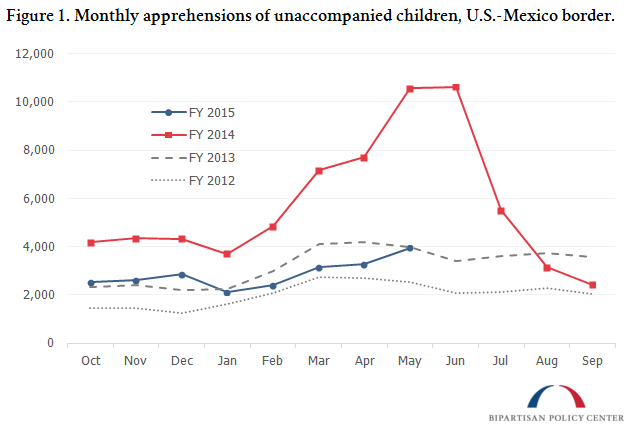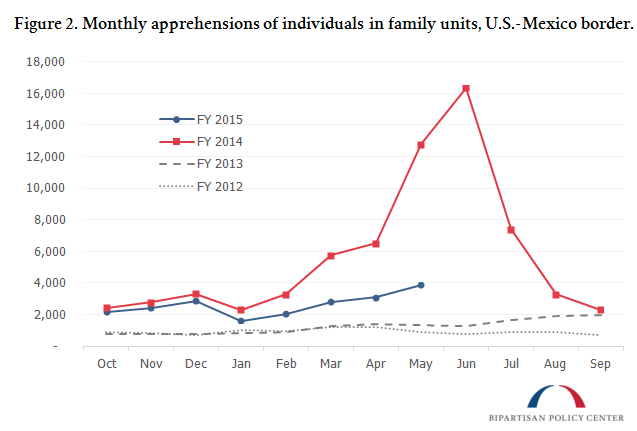Border Apprehensions of Central American Children and Families Continue to Fall
Key takeaways:
- Compared with the same time period last fiscal year, monthly apprehensions of unaccompanied children, family units, and Central Americans are each down by about 50 percent.
- The number of unaccompanied children apprehended in May 2015 was about 37 percent of the May 2014 total. For five straight months, unaccompanied child apprehensions have been below the totals seen two years ago in FY 2013.
- Family unit apprehensions started the year close to last year’s totals, but have declined precipitously since then. In May 2015, family unit apprehensions were less than one-third of the May 2014 total.
On Monday, Customs and Border Protection (CBP) released its monthly update on the number of unaccompanied children (UC) and family units apprehended at the U.S.-Mexico border. Last year, record numbers of children and families from Central America arrived at the U.S.-Mexico border?enough that, for the first time ever, more than half of migrants apprehended by the U.S. Border Patrol were not from Mexico.
Through the first eight months of fiscal year (FY) 2015, the number of UCs, individuals in family units, and Central Americans apprehended at the U.S.-Mexico border has continued to decline. Compared with the same time period last fiscal year, UC apprehensions have declined about 51 percent, from nearly 47,000 to nearly 23,000. Similarly, the number of family units apprehended declined 47 percent, and the number of non-Mexican apprehensions declined 48 percent.1 The large majority of non-Mexicans apprehended at the U.S.-Mexico border are from Central America.
Monthly data reveal a growing divergence between FY 2015 and FY 2014. In each of the past four months, UC apprehensions were less than half of their FY 2014 total, and in each of the past five months, UC apprehensions were lower than the totals seen two years ago in FY 2013 (Figure 1). This decline has accelerated in recent months. In each of the first three months of the fiscal year (October-December), UC apprehensions were at more than 60 percent of their FY 2014 levels. By contrast, in each of the past four months (February-May), UC apprehensions were less than 50 percent of their FY 2014 level. In May, UC apprehensions were 37 percent of the FY 2014 total?the lowest month of the year.
Source: CBP (archived monthly updates), DHS.
Family unit apprehension numbers this year are still much higher than in FY 2013 or FY 2012. Compared with last year’s trend, however, family unit apprehensions are diverging even more quickly than UC apprehensions. Over the first three months of FY 2015 (October-December), family unit apprehensions were nearly 87 percent of the previous year’s total. In subsequent months, this figure dropped sharply. In May 2015, about 3,900 individuals in family units were apprehended?about 30 percent of the total seen one year earlier (Figure 2).
Source: CBP (archived monthly updates), DHS.
Last year, UC and family unit apprehensions increased steeply in late spring and early summer, with May and June seeing far and away the largest number of migrants arriving at the border. This May’s numbers provide the clearest evidence yet that children and Central Americans are being apprehended at a slower rate than last year?in fact, the gap has only accelerated as the year has worn on. Though June could still surprise us, it appears increasingly unlikely that this year’s apprehensions of children and families from Central America will even approach last year’s levels.
1 CBP (2015), “Southwest Border Unaccompanied Children.” Non-Mexican apprehension comparison based on archived version of the page.
Share
Read Next
Support Research Like This
With your support, BPC can continue to fund important research like this by combining the best ideas from both parties to promote health, security, and opportunity for all Americans.
Give NowRelated Articles
Join Our Mailing List
BPC drives principled and politically viable policy solutions through the power of rigorous analysis, painstaking negotiation, and aggressive advocacy.

